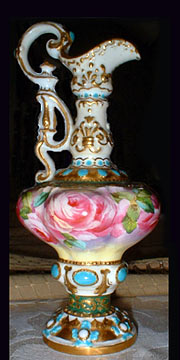|
|
||||
|
Third America's Cup Found New York, April 1, 2008
The New York YC announced Tuesday that the Third America’s Cup had been discovered in an obscure vault members had not inspected for nearly a century. Minutes of NYYC’s Cup Committee meetings from 1887 reveal that the Cup, pictured at left, is the actual trophy donated to the Club by George Schuyler in 1887 to accompany the Third Deed of Gift. "It turns out that the club under the original Deed didn’t have the authority to return the 1851 silver piece to Mr. Schuyler, the last of the living original syndicate members alive at the time," said Ron Grumanheer, NYYC archivist. "So Schulyer’s wife commissioned a new, and quite remarkable, trophy from Josiah Wedgwood & Co. while on a European tour, and the Schuylers donated that trophy under the Deed." Robert L'Poissonier, dean of America’s Cup journalists, points out that it is this trophy that a winning challenger is entitled to under the Third Deed of Gift. An emergency hearing in the commercial division of the New York State Supreme Court resulted in an order issued Monday by Justice Herman Cahn, assented to by the Federal Justice and Police Department in Bern, requesting the Parquet du Procureur General of Geneva to implement return of the 1851 trophy and place the proper trophy in repose at the Société Nautique de Genève. The original Cup is expected to arrive in New York Wednesday. "We were as surprised as anyone," NYYC Commodore E. Thomas "Buffy" Hardlington VI said in a Skype interview. "But apparently the foresight of George Schuyler was even greater than we ever thought. Knowing that the America’s Cup would eventually become the subject of contentious legal wrangling as the looming 20th and 21st centuries inevitably arrived and all decency went by the wayside, he made sure to keep the original historic trophy safe, and instead deeded this horrid dust bunny." Hardlington VI detailed the rest of the club’s 1887 strategy. "After the secretive Thistle challenge scared the defenders, the Club committee expected that the Earl of Dunraven would likely prevail in his upcoming challenge, and if not him, perhaps a determined entrepreneurial challenger emerging from Britain’s newly wealthy classes. And when they won, this was to be the prize, a newer, 'modernized' America’s Cup, better tuned to the sophisticated tastes of 1890's society. The committee wanted to make sure that whatever happened, a 'successful' challenger could take the new Cup back with them to Europe and finally leave the knickerbockers in peace, with the true America’s Cup remaining safely in the Club trophy room. "In a pre-internet, pre-color photography age, they thought that they had a pretty good chance to get away with it. With the participants on both sides from the 1851 race passed away save for Schuyler, nobody in Europe knew what color the Cup really was, and this flashy glazed bauble should have distracted the British sufficiently so that they would never realize that they’d been had, especially in bright sunlight.” How did the plan fail? A diary entry from October, 1908, found in the uncovered vault, records decades of incredulous disappointment as challenger after challenger failed to claim the prize. "We thought, yes, well, Dunraven wasn’t very ept, but this Lipton gentleman, surely he can win one of these days. We tried to throw the races for years, wrote the rules to make it easier for them, but we kept winning no matter what we did, it was most maddening. What more can we do to get a challenger to win?" The vault was apparently closed on the eve of WWI and when racing resumed in 1920, aging membership had forgotten its existence. The "Newer Ewer" of 1887 is rarer than first thought, as markings on the bottom reveal that it was executed for Wedgwood by famous Spanish architect and artist Antonio Gaudi, in what art historians refer to as his early peyote period, before the psychotic effects of mescaline had become scientifically understood. That it's the only extant porcelain international yachting challenge cup known to have been designed by Gaudi adds immeasurably to its value. L'Poissonier notes that this means that the original silver trophy of 1851 is still the New York Yacht Club’s rightful property, and following its imminent return it will be subject to challenge under the original 1857 Deed of Gift. "Considering that the 1857 document permits a defense by a fleet of challengers, requires only six months notice, and the only limit it places on yachts is that they be between 30 and 300 tons Customs House rule, with no provisions for ocean courses, own bottoms, or other patently unfair restrictions of that sort, the next America’s Cup should be a spectator’s feast, at least once designers are finished with plans for the fleet of 30-ton multi-hull yachts that will take on the challenger in a match sailed inside New York harbor."
Press releases from Defender
Alinghi and Challenger BMW Oracle indicate that both teams are
pleased with the news, and have directed their lawyers to draft
letters to Justice Cahn detailing just how pleased they are.
A statement from Vincenzo Onorato of Mascalzone Latino has been
loosely translated from Italian as reading "No way, I am not
saving that thing."
Interesting Links:
|
